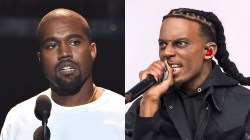How many times have you heard this phrase: “Oh they’re just trying to act black”? Or how about the phrase “Why are they trying to act like they are Asian?” Too many to count? As the debates rage on, it is a relatively good time to ask the question “Who is stealing from who?” when it comes to American and Asian culture. Both are seen as highly influential across the globe but only one can reign supreme…right?
Love it or hate it, much of what you love in American culture has been “borrowed” from Asian culture while Asian’s often take out a loan from American Hip Hop culture. From Wu-Tang Clan’s affinity of Kung Fu flicks and the upcoming big screen Asian horror adaption Shutter to Nigo’s BAPE and Asian emcee Jin, everything that you might think began in one place really hasn’t at all.
In Hip Hop culture, some of your favorite artists are inspired by Asian imports. Take streetwear for instance. Some of the most innovative concepts in streetwear are nothing more than Asians being influence by American Hip Hop culture, retooling the concept and presenting their take on it – with a eastern twist. It can be said that these ideas are “stolen” or “borrowed” from their American counterparts, but the truth is that there is a certain love and respect for the culture that leads to innovation. What we take for granted, Asians take seriously.
Lest we forget that most of the styles Asians rock do nothing more than pay homage to the dress and style from groups like Run-DMC, KRS-ONE, Big Daddy Kane and anyone else rocking a fat dookie rope in the late ’80s and early ’90s. Some of the flyest streetwear companies are spearheaded by Asians. Just take a look at Crooks & Castles and you can see the inspiration.

AD LOADING...
Hip Hop in America is possibly the most interesting thing to witness in the new millennium. Gone are the days where concerts were filled with “fans” who just loved what the performer was doing. These days, there are more kids in the crowd dissecting what the rapper is doing wrong while thinking about how they can get on and sell millions of records. Today’s crowds are filled less with fans and more with aspiring rappers. In the Far East, fans are strictly fans. Those that actually partake in the culture study and study hard. From break dancing to graffiti, the elements are respected much more than they are back home. How about the irony that one of the top groups on Randy Jackson Presents America’s Best Dance Crew is an all Asian group named Kaba Modern that utilizes elements of west coast popping and locking along with finger tutting? Is it homage or thievery?
While many may say “Those Asians need to stop stealing from us,” hold your horses because many of us back here in the good ol’ U.S. of A. do our fair share of swagger jacking our Eastern counterparts.
Although we adore the Wu-Tang Clan and look at what they have done as groundbreaking, their whole style was lifted from Asian culture. Each of the Wu members borrowed heavily from a Kung Fu flick and repackaged it for our consumption. Lupe Fiasco is yet another of our beloved Hip Hop kids who often pay homage to Asian culture through music and fashion. Lupe often alludes to his love for Manga, which is a huge publisher of Anime titles such as Ninja Scroll and Ghost in the Shell. His love for giant robots and admiration for technology in his lyrics provide further examples of his respect for the culture (check out his second verse on “Gold Watch” for the numerous Asian name drops).
But while Wu-Tang and Lupe are pretty obvious with their admiration, many Hip Hop artists are paying homage to Asian culture in not so palpable ways. Lil Wayne could be seen as the poster boy for BAPE with his numerous appearances in the Bathing Ape gear while Kanye West’s video for “Stronger” was heavily influenced by the much heralded anime Akira. The Asian elements of martial arts, philosophy and war strategy play a big part in the make-up of dead prez. Once again, is this thievery or homage?

AD LOADING...
The borrowing of cultures in not just limited to Hip Hop however.
Asian horror is possibly the most recent item “borrowed” by the US. When The Ring released in 2002, millions flocked to the theaters to see this innovative film about a mysterious videotape that kills people in seven days. Many horror fans loved it, but very few knew that they were watching a remake of a Japanese hit. After the film raked in nearly $120 million, Hollywood got a clue and began gobbling up Asian horror like there was no tomorrow. The Ring 2, The Grudge, The Eye, Dark Water, One Missed Call and Pulse all popped up within the last 5 years as registers all over the U.S. could be heard cashing in on the latest trend. But the keyword here is trend.
The latest to make its way to the theaters is the upcoming Shutter which uses the Asian concept of “spirit photography” as it’s premise.
With Asian horror, the plot is incredibly thick as the buildup can take up to an hour before there is a payoff for the viewer. Most of these films are about the dead, utilizing supernatural themes that are intricately weaved into the film. There is no hack and slash (with gratuitous nudity) or zombies chasing helpless women. It’s all about revenge and nobody does it better than Asians.

AD LOADING...
If anyone has seen an Asian horror film before the American remake, it may be safe to say that there were some subtle changes in the translation to appeal to American viewers. With the exception of The Ring, many of these changes cause the film to fall flat on its face once translated (with fresh new American faces) and delivered to North America. The plots are usually thinned out in an effort to keep viewers engaged. But because of this, many of the brooding elements that made the original a smash overseas are lost in translation.
Without giving the plots of key movies away, most remakes focus more on the “star” rather than the concept. Films like The Eye (Jessica Alba) and The Grudge (Sarah Michelle Gellar) center around the main character and the logic for the haunting are less complicated and engaging than the originals. Call it “Asian horror for dummies” if you will.
Why not just bring over the original and either use subtitles or dub it like a kung fu flick you ask? The answer is not an easy one, but it is probably pertains to something along the lines of an audience culturally identifying with what appears on their screen. Also the brutality and gore in some Asian films would never get past the ratings board here in the states (watch Ichi the Killer or Oldboy to comprehend).
It isn’t just horror flicks however, as one of the biggest action movie heroes of all time just so happened to a guy of Asian descent by the name of Bruce Lee (and let’s not forgot how Jean Claude Van Damme was just a wack American version rip off of him). Today’s breed of action films has been held down by the likes of Jackie Chan and Jet Li.

AD LOADING...
Even your favorite video games have borrowed heavily from Asian culture. The obvious is the popularity of the Street Fighter series while the horror genre games such as the cult classic Fatal Frame are built strictly around Asian concepts. To say one side is pilfering more from the other is basically the pot calling the kettle black.
So who is at fault in this classic case of culture swagger jacking?
Nobody.
Although many things end up lost in translation between American and Asian cultures, the one constant element that must be maintained is respect. We’ve learned a great deal from Asian culture while the proof is in the pudding that Asian’s have often admired what America has brought to the table. No need for the finger pointing. Simply enjoy both cultures and I guarantee that you will become a well respected and diverse individual. Now I’m off to watch Fist of the North Star in my Crooks & Castles hoodie while sifting through my collection of BDP CDs.



